
Today, blogging is NOT just a hobby for teenagers or those who love writing about everything they experience in their lives.
On the contrary, businesses and professionals use blogs to engage with their audience and to ultimately improve their inbound marketing strategies for a more positive ROI.
Before, online customers would just pick the product they like, pay the amount, and then go to the next online store. But now, many customers read blog posts or any informative and helpful write-up regarding a product they like before they make a purchase.
An eCommerce owner already has the advantage of selling products that customers are searching for. They just need to improve their marketing efforts with truly helpful, informative, and compelling blog posts to engage with their existing customers, their referrals, and prospects.
That’s where you, as a copywriter, jump in.
When writing a blog post, a writer should be able to determine a good topic that fits the products and the business as a whole. You need to write posts with your customers (and would-be customers) in mind in order to truly get their attention and to supply the information they need to help them decide and make a purchase.
Easier said than done!
But how to come up with all those fresh ideas for writing blog articles regularly without repeating the same content over and over again?
That’s exactly what we’re going to teach you in this lesson! Once you’ve finished it, you’ll NO MORE find generating ideas for your blog articles tremendously difficult. You’ll see that you don’t have to be a creative genius to provide useful and compelling content almost every day.
You can’t believe it? Go ahead! Check out this lecture! What are you waiting for?!
Ready?
But before you can even think about generating ideas for your blog posts, FIRST you need to understand your audience. So, let’s see what you should have in mind about your audience.
Put Yourself in the Shoes of Your Audience
If no one’s going to read your blog post, then there’s absolutely NO point writing it, is it? But you CANNOT make people read it, right?
What can you do about it, then?
Well, you CAN have your target readers in mind while thinking about what to write and make your content interesting enough and relevant for them, so that people really WANT to read it. Be aware of their problems and concerns and offer them solutions in your articles.
To achieve that, you have to think carefully about the following:
1. Who are you writing for i.e what type of customers? You can’t generate ideas and write for someone you don’t know. So, before you start thinking about what to write, make sure your target reader can identify with your content and finds it useful and enticing.
Ever heard of the term buyer persona?
Here’s how to create detailed buyer personas. Or you might prefer this article on how to build buyer personas? Or perhaps this one?
You wonder why you need a persona-based content marketing strategy? Follow the link to find out. Also, get familiar with the benefits of buyer personas for content marketing.
Meticulously crafted buyer personas can help you identify their interests and motivations, communicate with them on their own terms, and keep them top of mind throughout every step of your content marketing process. (Read the full article on how to create them)
Use your blog posts strategically by posting content that will appeal to each one of your buyer personas. Then, when you’re communicating with a prospect that you’ve sorted into a specific persona, you can reference individual blog posts that reinforce your sales pitch in an educational – yet persuasive – way. (Find out more in this complete guide to developing and using buyer personas)
Not every reader will be fond of the same content.
So, ALWAYS keep your target audience in mind when writing. Give them a story they can easily relate to.
The more targeted your content is, the better!
2. What are they buying? Are they buying luxury goods to improve their social status? Or are they perhaps buying kitchen utensils that make them more efficient at home? Or maybe they need those kitchen utensils because they run their own restaurant? Oh, yes, it all REALLY matters!
3. What motivates them? Why do they want to buy a certain product? Are they motivated by the price or by the usefulness of the product? Are they interested just in the status of owning a certain object or something else?
So, the very first thing to work out BEFORE you start thinking about how to generate ideas for your new piece of content is to find out more about your target audience. OK?
Here’s a good example of a shoe store that addresses their target audience needs well – shoes.com. Let’s take a glance at their blog post titled What to look for in a work boot.
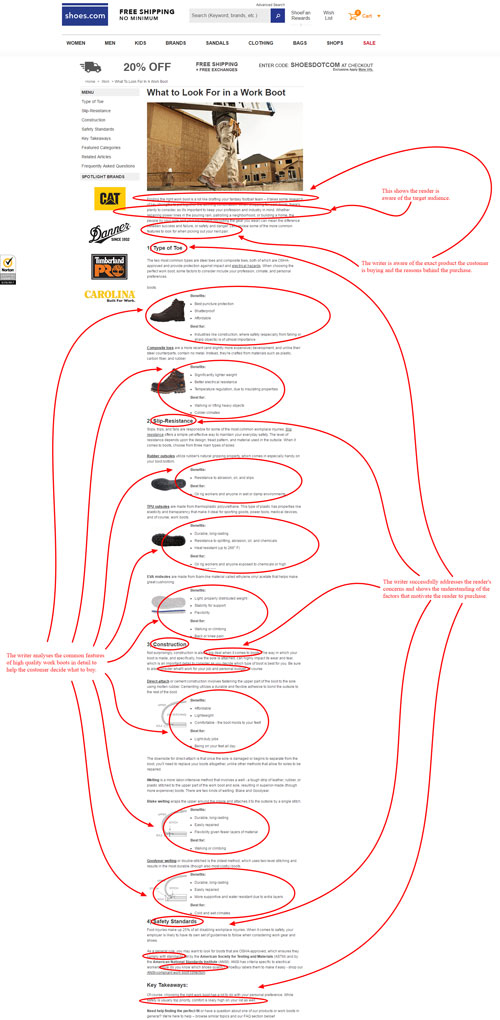
And now let’s analyse it briefly.
- Is it clear enough what type of customers they’re writing for?
Yes! This blog article is aimed at e.g. construction workers, policemen, farmers or any other professional/craftsman who wouldn’t be able to perform their daily duties at work outdoors without a pair of high-quality work boots.
- Is the writer of the article aware of what specific product the target reader is buying and the reasons behind the purchase?
Undoubtedly! The writer shows a deep understanding of the product and its effects on the customers. In simple words, the writer knows that they’re writing in order to motivate the above-mentioned target reader to shop for these work boots so as to work more efficiently and safely.
What’s more, the writer helps the target reader decide and pick the right work boots based on their profession and specific needs.
- Does the writer know and take into consideration the factors that motivate the target reader to buy the product?
Definitely! The writer addresses all the reader’s concerns clearly stating that these work boots comply with the highest safety standards, that they are comfortable, durable, resistant, and affordable – everything the target audience is looking for.
Understand?
Now, finally let’s check what can help you easily come up with some brilliant, wacky ideas for your blog posts. Just follow these useful tips and there’ll be NO need to worry, you’ll see!
For the sake of illustrating the main points presented here with an example and explaining how it all works in practice, just imagine you’re a copywriter working for an online store selling shoes and you have to come up with some fresh crispy blog post ideas while facing a blank document. Ah, yes! And your deadline is pretty tight – tomorrow. But no pressure! 🙂
Sounds a bit daunting, doesn’t it? Let’s figure out what you can do to help yourself.
Idea #1: Brainstorm With Your eCommerce Store Owner and Colleagues
You and your eCommerce store owner should find time for brainstorming especially if this is your first time to write and publish a blog post on an eCommerce website. Use this time to jot down all the possible topics you can post and agree on a posting schedule in order to maintain consistency of your blog.
It is also ideal to have brainstorming sessions with the rest of the staff to get their inputs on ideas you have in mind. You can ask your employer to set a schedule just for this activity in order to get everyone’s inputs so that you’ll always have a list of information, ideas, and possible topics to blog about.
How come that those people who work with you can be a treasure chest full of writing ideas? It’s because all your co-workers approach the same business from different perspectives.
For instance, a sales representative knows what makes a customer want your products and finally hit that ‘buy’ button.
Is it the unique design of your shoes, or maybe the price, or something else? Perhaps you might write about Top 10 classy ladies’ shoes for this spring? Of course, sneaking your models in those top 10 ones goes without saying. Talk to the people around you to get more ideas!
Similarly, your customer service peers know what challenges and difficulties customers have with your products, and the like. You may want to turn your customers’ pains into your blog topics, so listen to your colleagues carefully and make notes.
Addressing your customers’ problems, you may find it useful to write about something like this:
- Want to avoid developing bunions? These incredibly comfortable shoes can save you from a lot of pain! (A similar real-life example: Best shoes for foot pain)
- Or you can write something like: 5 easy ways your wide feet can look amazing in classy high heels. (A similar real-life example: Tips for finding the perfect wide calf boots)
Got it?
Consulting your peers is a wealth of fresh ideas and perspectives!
Make sure you write down every idea while brainstorming no matter how dull it seems at that moment. You never know what brilliant ideas might spring up from a dull one.
Of course, although you think you’ll be able to remember it later, you probably won’t. So, PLEASE, write it down.
In this blog post, Sujan Patel, an expert in digital marketing, elaborates on 11 Brainstorming Exercises to Generate 100 New Blog Post Ideas. Check them out because they can help you get some quality ideas in the blink of an eye when experiencing that scary writer’s block.
Hubspot’s created a brainstorming spreadsheet with a guide on how to use it to brainstorm your ideas in a fast and visual way. It may also help next time you face that blinking cursor at the top of the white page while the clock is ticking, so you may want to check it out.
What else can you do besides brainstorming with your co-workers? The answer follows…
Idea #2: Get the Feedback From Your Suppliers or Store Owner and Check the Store’s Website
Writing a blog without an idea in mind could make or break your blog post. And it is NOT an easy task to just write without anything particular in mind.
That’s what you know for sure but what you DON’T know is what else to do when new ideas just won’t come into your head. Let’s see how the following tips can help you.
Check the store and products for inspiration, and take note of everything you find interesting and worthy of a blog post. You can write about the origin of the products, how they’re made, their features, and so forth.
Use ideas from product description pages to show people NOT only the characteristics of products but suggest how they can use certain products in new different ways, for instance.
Make them alive in your articles by putting them into use in the appropriate contexts and situations.
Then, write about your product benefits. You may want to write an article for each benefit of a certain product or to showcase one benefit from different angles.
For instance, you can write about:
- How wearing these 7 effective elegant shoes can help you get your dream job,
- 11 simple ways you can wear these shoes and look glamorous every day,
- How to find cheap comfy shoes to wear barefoot, or
- Life hacks: how to choose perfect non-slip boots, etc.
Here’s a real-life example of a blog article talking about the product benefits: A guide to finding the warmest winter boots.
You can also ask the store suppliers for, let’s say, new product lines that are about to be released. What’s more, you can call them up e.g. once a month and ask them what’s selling. You can also check what’s popular on their website.
Those are good ideas for succeeding posts, such as, for example, 13 best walking shoes in 2017: what’s changed or Shop the latest style sandals.
In addition, you may also want to take a look at ratings, recommendations, and reviews on product pages, but we’ll talk about that in details in the following subsection. For now, here’s just a real-life example of a blog article based on customers’ reviews: Best work boots.
All in all, the point is to know what your customers want and what you have to offer by looking at the store and the products in it.
Idea #3: Gather the Precious Customer Feedback for More Ideas
You should also look at the customers’ feedback from various sources to find inspiration for your blog articles – check all the possible messages, good or bad, positive and negative.
How exactly can you do that? Here are some ideas.
Check Your Customers’ Emails
Well, once a customer has purchased from an online store, they have the customer’s email address and they should be setting up an email order respondent notifications saying something like: ‘You’ve recently bought X, what do you think about it? Are you interested in this similar product?’ or just confirming their order or thanking them for purchase, and the like.
Here are various email types online stores might be sending to their customers and the benefits of sending them so that you can get a bigger picture.
Here’s another benefit of emailing customers, which is crucial for you – when they get the answers from the customers, you can use them as starting points for your blog article content ideas.
Search Social Media
Apart from e.g. follow-up emails, you can get customer feedback by the testimonials people give you from social media networks.
So, go to the store Twitter, Facebook, or any other social media account it has and check what people talk about, what products they like, need, dislike, have problems with, and so on. You’ll get a whole bunch of content ideas.
Moreover, you can even go out and give customers a survey asking them for feedback on the store, its products, service, website, blog topics, what they would (not) like to read about etc.
Either by searching through the most shared and popular posts on social media (related to your industry, of course) or simply by asking people well-tailored questions e.g. via tweets or private messages, you’ll be able to find out what blog posts they liked and responded to lately and what content formats they preferred.
Mine those for content ideas and when you figure out what works, do more of it!
Here’s more on how to conduct research with social media using the three biggest networks – Facebook, Twitter, and Instagram.
Ask people anything you like and think might help you but carefully phrase the questions to get precise and valuable answers you can use.
Another tactic to rely on is searching different social media groups or forums on the Internet (such as Quora) where you can expect your target readers to appear and be active. Is there a better insight into their thoughts, concerns, and opinions on certain topics? Not likely.
Then, why wouldn’t you take it a step further and do the following?
Invite Your Customers to Contribute
Yes, you’ve read it properly. Don’t be surprised because it’s nothing spectacularly new. Smart people have already been doing it for a while.
Here’s an example of a wise campaign of Coffee For Less which engaged their customers in a monthly Blog Comment Contest, encouraging them to read their blog posts and leave comments, which can and probably later will lead to excellent ideas for blog topics.
This is a good example of leveraging some user-generated content.
Modcloth’s blog is another fantastic example of utilising user-generated content successfully so you may want to take a look at it, as well.
Done? Aren’t they brilliant?
Then, check out how Gelly Roll display their customers’ social media posts with photos of people having and using their products happily. Isn’t that highly persuasive?
Why wouldn’t you gather loads of such valuable and genuine content and use it for the store blog posts? It has multiple benefits.
User-generated content – content created by consumers and publically available online to other users – gives value, adds credibility and sparks online users’ interest in a brand.
When skillfully integrated into overall marketing strategy, user-generated content helps companies grow their following, encourage customer loyalty and, ultimately, increase sales.
So how can companies leverage the power of content contributed by their audience to promote their own brand online? Read the full article and find out.
Today, best-in-class companies are empowering their customers to take on a central role in growing their brands – as advocates, storytellers, and co-innovators. And user-generated content (UGC) is likely the next hot trend in marketing.
Savvy businesses like Starbucks are quickly realising that in order to achieve a deeper level of customer engagement and brand loyalty, they need to humanise their brands by connecting with customers at a personal level. They are capturing real stories from real people and weaving them into their marketing campaigns.
And today, some companies are taking advantage of interactive social media platforms such as Instagram and Twitter to engage customers directly in developing more impactful and personal brand stories.
Read more about 3 Brands Harnessing the Power of Customer Generated Content to Boost Engagement
Isn’t this a marvellous idea? What else can help?
Monitor a Store’s Live Chat
Next, you can gather some feedback from a store’s live chat. If customers are talking about the same concerns and asking the same questions over and over again, maybe it would be a good idea to address them in the store’s blog posts, too.
Never mind if they’ve already been included in the FAQ or Help section. Moreover, you can also find the inspiration for your articles in these sections.
Take a peek at how Shoes.com did it. They took two of their frequently asked questions (shown below) and incorporated them into a blog article.
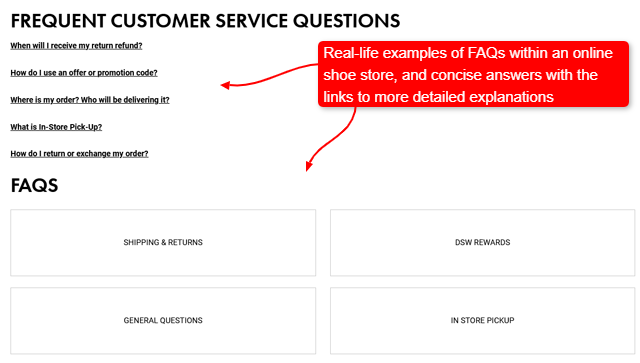
Now, take a closer look at a more detailed answer to one of the questions above. You can see it when you click on the link they suggest as ‘Read more here’. They provide the customers with a more detailed easily readable answer to the question from their FAQ list.
Moreover, they offer links to their blog articles related to the topic for further information. You see?
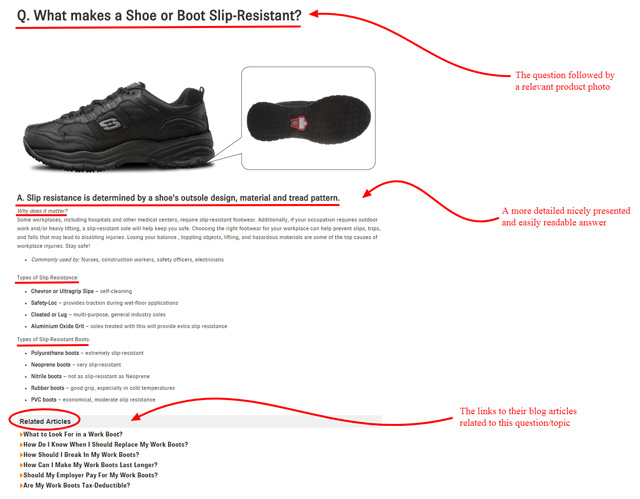
Finally, here’s a blog post (also shown as an example earlier in the lesson) which includes the two questions from their FAQs previously mentioned.
In this article, they provided readers with a broader context and even more details about the topics of their interest, getting inspiration for the company blog content at the same time. Isn’t that super convenient?
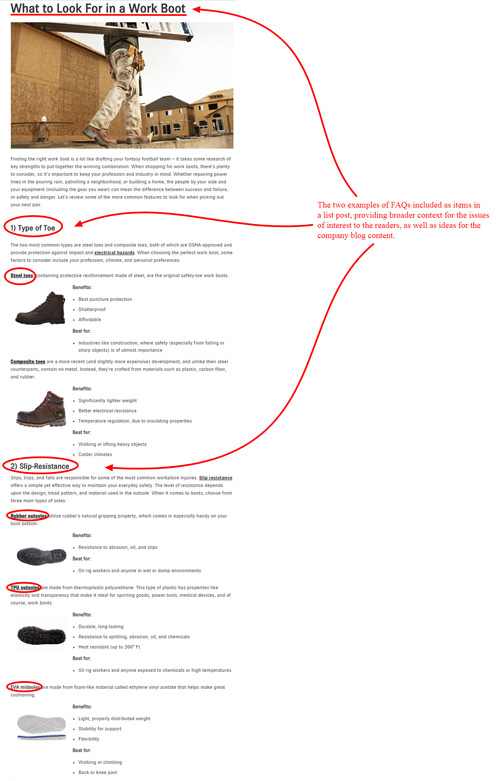
Got it? Feel free to take a look at the other FAQs within this shoe store and think about various topics a copywriter working for them could cover in their blog posts. You’ve suddenly come up with a plethora of ideas, right? That’s exactly what we’re talking about.
You see how getting fresh ideas for your blog posts is gradually becoming easier and less stressful? And we’re just somewhere in the middle of the road now. Let’s continue!
In addition to gathering feedback from different available sources, you can use your old content as inspiration for some new articles. Unbelievable, isn’t it?
Here comes the magic!
Idea #4: Review or Repurpose Your Old Content
Ran out of brilliant ideas? Don’t worry! You can always revisit your old blog article topics with new posts. Why not?
Sounds good? But how can this be done?
For start, use various helpful tools such as Google Analytics (more on this a bit later) to check your most successful old posts and think of the ways to update and refresh them. Perhaps you could find better images, or new statistics or research results to support your points, or you can refer to some better resources that weren’t available before.
Go ahead! Find out which old posts of yours were the most popular ones and polish them up a bit. You have no idea how? Here are a few suggestions.
Update Your Old Content With the Latest Information
Let’s say you’ve written an article like this: 5 high-heeled shoe trends in 2016 every businesswoman should be aware of. Now, you can create a new article such as: Businesswomen! Pay attention to these 5 high-heeled shoe trends in 2017!
Just update your old content with the latest information and that’s it – you’ve got a brand new idea and article!
Here’s another example of a quick makeover. If the title of your OLD article is, let’s say, Unravelling 7 shoe tips every trendsetter must know in 2015, you may develop a new idea out of it, such as 2017 shoe trendsetters’ secrets revealed.
Not that difficult at all, right?
You’re definitely bound to increase your new blog article popularity since it’s based on an old highly popular post.
What’s more, you can boost your search ranking by internal linking, that is to say, linking your new blog post version to the old one or vice versa.
Approach the Same Topic From a Different Perspective
Another approach to recycling your old posts is to observe the same topic from the opposite angle and use different examples. As simple as that!
It’s the easy way out because you’ve already done thorough research on the topic. All you need to do is to spice it up with the opposite viewpoint. Can it be easier?
For instance, if you’ve written an article on 11 ways to wear these incredible shoes this spring, try something like 11 mistakes not to make with these incredible shoes this spring. Or if your old content is about 10 reasons to buy these shoes, you could now write about 10 reasons not to buy these shoes.
This playing devil’s advocate is genius, yet so simple, isn’t it?
Present Your Old Ideas in a New Form
But there’s much more to it! You can also re-package your old content. It means that you can present it in a different form if it’s evergreen or still relevant. You just have to think of new ways of expressing old information to attract some new readers.
For instance, if you’ve written your old article 11 ways to wear these incredible shoes this spring in the form of a listicle or curated collection, you can now present your ideas in the form of an infographic or inspiration gallery.
Some other formats your old ideas might be exposed in are videos, podcasts, SlideShare presentations, comics, etc. Some people don’t like to read but prefer visual or audio presentations of information.
Thus, try to diversify your content forms as much as you can.
So, take a peek at your old content and see what you can use for inspiration.
But that’s not all! Keep reading to find out more.
Idea #5: Check Your Competitor’s Content and Social Media Accounts
Not only can you take advantage of your own old content and clients’ feedback, but you can also analyse your competitor’s store blog, website, social media posts, or their clients’ comments and get precious ideas.
Read through your competitor’s most popular/commented blog articles, find out what you can do to improve them and do it!
Of course, be careful – this does NOT mean you should spy on them and copy their unique content! On NO account is that acceptable!
Just look at what people are talking about on their social media channels, think of the ways you may expand on their topics, perhaps include better research or examples and create a better blog article on the same/similar topics. Always change the headline, of course!
Basically, almost whatever you can do with your own old content and customers’ feedback (ideas 3 and 4 in this lecture) to create a better piece of content, you can do it with your competitor’s ones, as well.
Even more than that. Just make sure it’s ethical and legal!
However, in order to discover all the information that may be useful, you must know a bit about successful keywords research and how it can be helpful in the process of generating ideas for your blog posts.
So, let’s dig a bit deeper! (Also, make sure you check out our lesson on this topic linked above.)
Idea #6: Make a List of Keywords
Keywords are the currency of search engines and that’s why every copywriter should know something about them. You should always think about what people might type into Google to find your story and try to include those keywords in your title.
An outstanding copywriter is able to strike a title that appeals both to humans and search engines.
Make a list of keywords that are relevant to the products and business you’re writing about. That will help you come up with some crispy brilliant ideas for your content.
For instance, what would the keywords be if you were writing a post about comfortable shoes for a shoe online store? ‘Comfortable shoes’, logically, right?
When you make a list of keywords, you might ask yourself what types of shoes are comfortable, or what are some other words for ‘comfortable’.
Let’s take a closer look at various ways you can find unique and interesting keywords in your niche. The following tools can be of great help for keywords research.
Don’t hesitate to try them out (at least those you can access without a paid account)!
Google Keyword Planner
You can use Google Keyword Planner to check the traffic volume of the keywords that you have in mind. However, you can only use it if you have an AdWords account to access the features of Keyword Planner.
Here’s a detailed guide on how to use this tool effectively.
Note: Use keywords in the title and within the body of your post. Limit their occurrence within the body to 4 or 5 (ideal) times to avoid so-called keyword stuffing.
Here are some other valuable sources that can help you master the Keyword Planner better:
- Adwords article about using Google Keyword Planner
- Backlinko about Google Keyword Planner
- Moz on Google Keyword Planner
Ahrefs
The tools within Ahrefs are suitable not only for exploring keywords but websites and popular content, as well. Just pick a tool you need and get all the necessary information from around the web.

Get familiar with how to perform basic keyword research using this tool.
Let’s say you’ve picked a keyword that you want to rank for and now you need to create a compelling piece of content to target it.
How do you know the type of content that’s likely to be popular for this keyword? Content that is going to resonate with visitors, generate tons of social shares, bring in backlinks, and eventually rank well in search engines?
Simple: you use Ahrefs Content Explorer tool (also mentioned above) to find existing content that targets the same keyword and has already met these goals!
Here’s how to perform basic content research with this tool:
In addition, here are some helpful articles on how to do keywords research with it and some additional tips on how to use Ahrefs for SEO, content and link building.
Have we mentioned that you can also use all these tools we’re talking about for exploring your competitors? I bet we have. It’s awesome, isn’t it?
So, don’t stop at these introductory videos we’ve suggested. Keep searching the Internet for more targeted and detailed tutorials to help you learn how to use this precious yet simple tool.
But that’s not even close to the end of our tools list! What else can you use?
Various Synonym Tools
Fortunately, coming up with synonymous words or phrases can be the easiest way out when you hit the wall (figuratively).
Synonyms are words with the same or very similar meaning such as, for instance, buy and purchase. They help you stay focused on the topic and rank higher in search results. Great, right?
There are numerous free tools online that can help you vary your keywords without getting stuck. Not all of them offer synonyms only but definitions, antonyms, and other related keywords suggestions.
Some of the tools are:
Now, let’s check how they work since they’re free. If you had to write an article about comfortable shoes, for example, you may want to check synonyms for ‘comfortable’.
Here’s what to do with each of these tools. Go ahead, check them out and see what results you’ll get.
- If you enter your search term ‘comfortable’ into SEO Keyword Suggestion Tool, you’ll get 99 keyword suggestions but not a single synonym. Nevertheless, you can definitely make use of some interesting keyword suggestions to get ideas for your new blog post about comfortable shoes.
Here’s what you should do.
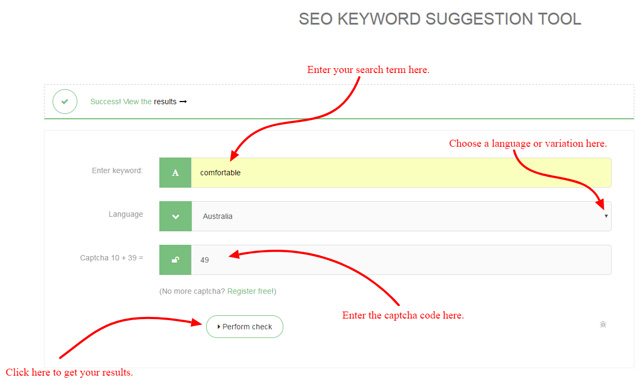
And here’s what the results look like.
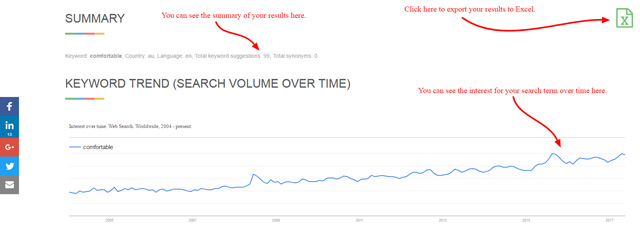

As you have probably noticed, there are NO results for synonyms of our search term, but there are plenty of interesting keyword suggestions (circled) that you can use as ideas to come up with the titles and topics of your blog post about comfortable shoes.
Some of the most interesting suggestions could be:
- Comfortable shoes for bunions
- Comfortable heels for flat feet
- Comfortable sandals for wide feet
- Comfortable sandals for toddlers
- Comfortable sandals with arch support
- Comfortable work shoes for nurses
- Comfortable walking shoes for Paris/travel etc.
You see? You can generate ideas easily with tools like this one!
- If you repeat the same procedure using the Synonym tool, not only will you get the synonyms but the antonyms (words which have the opposite meaning) for different meanings of ‘comfortable’, as shown below.
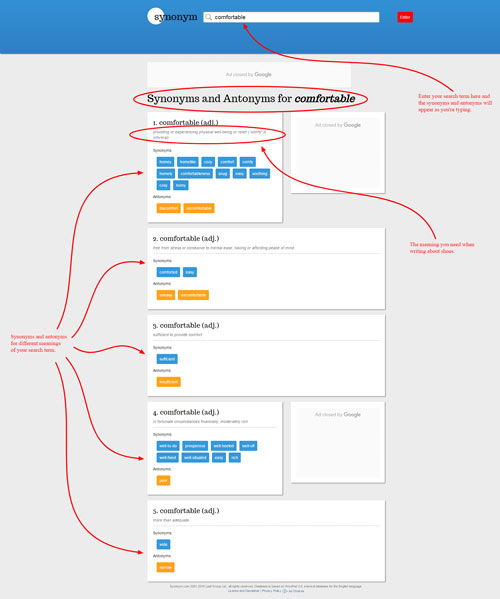
- If you use Thesaurus for the same search, these are the results you can expect.
- Here’s what it looks like when you use another similar tool, Merriam-Webster Thesaurus
- With MetaGlossary it looks like this.
You see how these great synonym tools can help you think of new interesting blog post topics?
That’s a great way to extrapolate and get more keywords out of your own list of keywords, isn’t it?
But that’s not all! Not even close! Here are some more tools and different ways you can do successful keywords research to generate your content ideas.
BuzzSumo
Another tool that actually functions as a search engine for viral content is BuzzSumo. Not only does it provide you with fresh content ideas, but it does much more to help you.
You wonder what it does? Keep reading.
It shows you top trending content and the social engagement it receives, that is to say, the number of shares on different social media (Facebook, LinkedIn, Twitter, Pinterest, and Google+).
It also identifies key shares and influencers, and it displays backlinks.
Moreover, you can filter your search by date and various content types, country, language, and domains. Isn’t that super helpful?
You can also enter your competitors’ websites and get access to their social networks sharing data. How amazing that is!
All this information can help you learn what’s trendy in your niche, what social networks are best for you to target, and what your competitors are doing great so that you can follow their footsteps.
Now, let’s see what results BuzzSumo will return when we search for the phrase ‘comfortable shoes’.
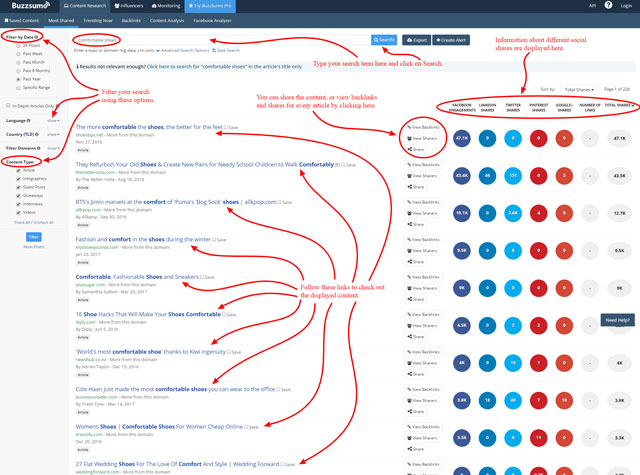
You can check out these articles to get more ideas for your blog post about comfortable shoes. Of course, you will NOT get any ready-made ideas and titles, just hints and triggers. Ready to dive into them?
Based on the search results above, for example, you can write a piece of content titled like this: How to survive a harsh winter without a beauty vs comfort shoe battle? Or perhaps something like this: 5 fabulous hacks that will change the way you wear your shoes.
Got it?
You’ll probably get some more interesting and original ideas once you explore the displayed content in depth and think about the topic carefully. All you need to do is analyse the content they offer, identify the pattern for success, and apply it to your own content.
BuzzFeed
If you want to see recent trends and which articles people really liked, BuzzFeed is the place to refer to. It’s a fantastic tool, something like a kind of a magazine where you can search for the keywords you need. It will give you a lot of ideas and themes people are responding to.
So, go to BuzzFeed, find out about the trendy topics related to your desired keywords, create your content around them and you’re bound to succeed.
Let’s demonstrate what happens when we search BuzzFeed for our keywords ‘comfortable shoes’. Here’s what we get.
Note: The results may look different depending on the time when you follow the link to check them.
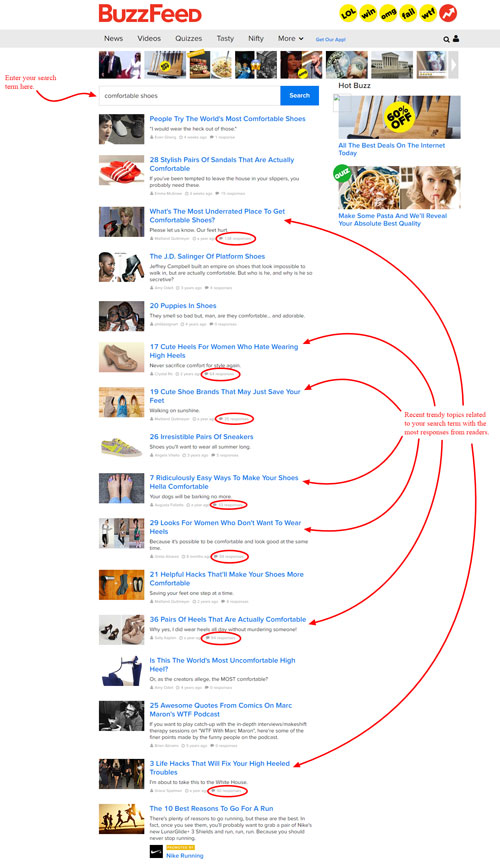
You may first want to take a look at the articles with the most responses (circled above). You’ll notice that those are the ones with the most enticing and catchy headlines.
They mainly consist of some:
- Unique numbers (17, 19, 7, 29, 36 etc.)
- Superlative phrases (the most underrated, hella comfortable, ridiculously easy, world’s most uncomfortable), or
- Strong emotional words (cute, hate, save, irresistible) and the like
For instance, based on this search, you may come up with ideas for your blog article like:
- 9 proven places to get stylish, comfortable and affordable high heels, or
- 13 best reasons to never leave home without your comfy shoes, or
- 23 irresistible pairs of shoes you can wear barefoot without getting blisters
Go on! You can provide some original titles based on the ideas from BuzzFeed for sure! Play and learn!
Google Analytics
Using Google Analytics will help you get into your readers’ heads and hearts more easily and quickly.
How’s that possible?
Well, Google Analytics has keywords data in it so you can actually say which keywords people are using to search and find your store’s website.
For start, Behaviour reports will tell you all you need to know about your content. Set up Site Search > Search Terms and you’ll see what terms people are already searching for. Some of their search phrases are your potential blog topics.
Then, you can take a look at Behaviour > Site Content > All Pages to check which pages are already getting traction and create new content around them.
Not only that! You can find out much more useful data to analyse and benefit from. Take a look at this beginner’s guide to Google Analytics.
Just ask your store owner to grant you the access to the store’s keywords data and a monthly report from Google Analytics. It should be enough to trigger more ideas.
Take a look at this step-by-step guide on How to Generate Content Ideas Using Google Analytics to learn more. You may also want to read these amazing tips on how to use Google Analytics as a content ideas generator.
Once you find the topics your target readers care about and like most, you’re on the verge of creating some brilliant valuable content your audience can certainly connect to.
Here’s also a YouTube channel you can visit to learn more about this tool and get some useful tips, as well as watch the video that gives you the instructions on how to setup Google Analytics. Also, you may refer to this article consisting of 5 videos that make it easy to set up Google Analytics. Enjoy exploring and learning!
Here comes another handy tool.
Google Search Console
What you can see in Google Search Console, previously known as Google Webmaster Tools, is how Google views your website.
Among many other things, which can help you to adjust the content on your website in order to improve its performance and Google traffic, with this tool you can find out:
- How people are finding your site and how many of them are visiting it
- Where those visitors are from
- What specific pages or posts they land on
- What keywords are most significant and related to your website, and so on
Using this tool, you may come across some keywords you didn’t know about. It’s possible to find some valuable keyword data from the Search Traffic section on the main dashboard. You’ll see two important tabs there:
- Top Queries – where you can filter your results by region, amount of traffic and search type (Image, Video, Web, All, Mobile). It gives information on keywords that drove traffic to your site, CTR (click through rate), and impressions.
- Top Pages – provide you with all the terms your URL showed up for, as well as data about the clicks, CTR, search impressions your keywords are attracting, and the like.
Once you discover the keywords that are attracting a large number of impressions, your task is to create and expand more content related to them.
Next, when you click on the Content Keywords item within Google Index menu, you’ll get the list of keywords Google finds when crawling the store’s website and considers the most relevant for it. They are important because they show you what Google perceives your site to be about.
Here’s how to set up this tool in case you need it. It can also be integrated with Google Analytics.
And here’s something more about what else you can do with it and how beneficial it can be. Have we mentioned it displays your competitors’ paid keywords too? Powerful, isn’t it?
You can further explore this tool and find out how it works by referring to their official YouTube channel or by following their blog.
A Simple Google Search
A regular Google search on keywords can also help. Just enter your keywords in the search box and check your search results. Simple, right?
Here’s what we got for our search term ‘comfortable shoes’.
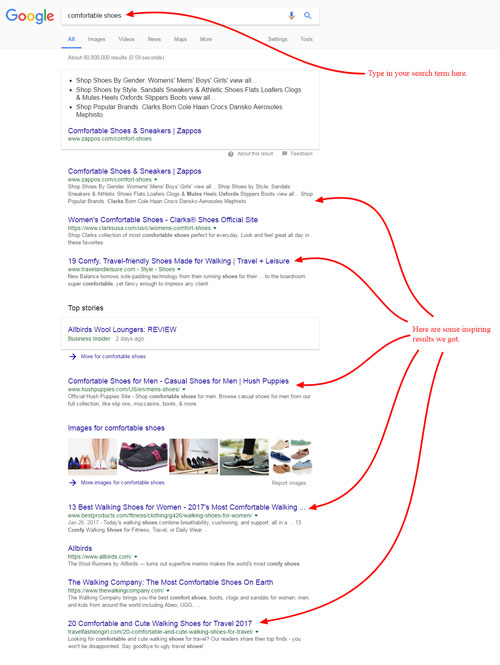
Based on these ideas you might, for example, write about 11 travel-friendly cute women’s shoes.
The next thing you can do is to use Google’s suggestions, that is to say, Autocomplete as an inspiration for coming up with new content ideas. You know, those phrases that show up instantly as you’re typing a search query?
They are based on current search trends, which means they’re most widely searched around the world and they can help you get good rank if you write a well-optimised post on a suggested topic.
How convenient that is! Check out how this option can be used.
Here’s what we get while typing in our keywords.

Nothing special this time but it’s a very helpful option that gives you ideas on how you can narrow down your topics and what subtopics people are interested in.
According to this example, you might write about How to find the best waterproof boots for women. Try to think of some better titles of your own.
Google related searches can also offer some amazing content ideas you can further expand and deepen. These are some similar searches other people perform around your keywords.
Let’s see what we get when we search for ‘comfortable shoes’.

These suggestions might inspire you to write e.g. about 7 comfy flats women can wear barefoot all day with no pain or, let’s say, How to stand and walk in flats barefoot all day without getting blisters.
You see how a simple Google search may come in handy in when you run out of blog post ideas? Go for it and include some more specific terms to get even better and more inspiring results. You won’t be disappointed at all.
Google Trends
When talking about how Google can help you generate more ideas for your blog articles, we have to mention another helpful option, Google Trends.
Simply type in your search term in its search bar and it will show you these trend metrics for your keywords:
- Interest over time
- Regional interest, and
- Related searches
Here are the results we got after entering ‘comfortable shoes’.
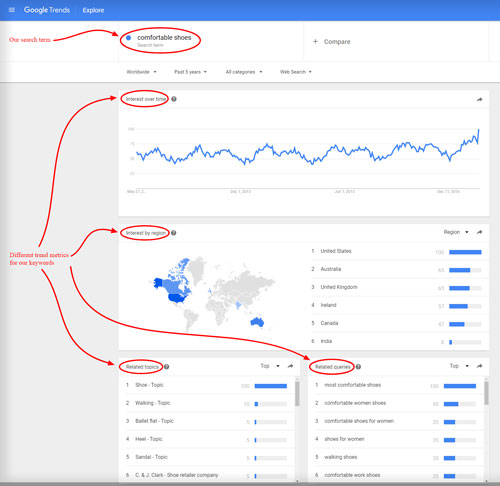
This way of checking out rising trends related to your keywords can also help you a lot with generating content ideas.
Moreover, you can use it to compare more keywords within your niche and you can also refine your search by various categories. Don’t hesitate to explore it!
Moz’s Keyword Explorer
Another quick and easy way to generate content ideas is Moz’s Keyword Explorer. This keyword research tool is also pretty simple to use.
Just enter your keywords, choose a language, and hit the search button. You’ll discover the best keywords to target based on search volume, difficulty, opportunity, and priority. In other words, you’ll get a list of potential blog titles for your topic in a few seconds.
Now let’s demonstrate how it works on our example keywords ‘comfortable shoes’.
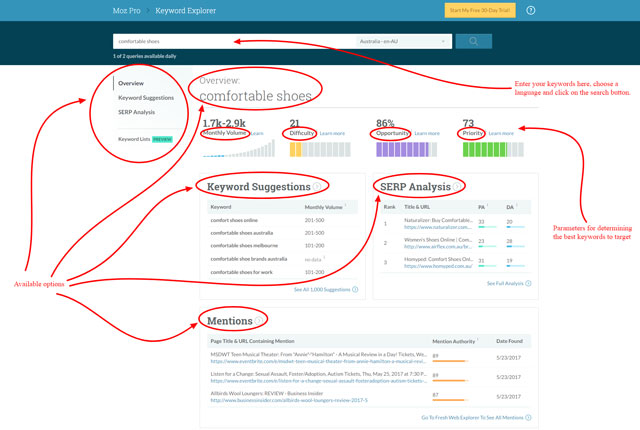
When you click on each of the options this tool offers, you’ll be able to find out more valuable information. For instance, once you get the results, it’s a smart idea to click on Keyword Suggestions option to see some inspiring ideas.
This is a part of what we get when we click on that option and dive deeper into the generated keywords. You can see more by following the link.

Moreover, you can further filter your search results to get the most out of these keyword suggestions. Here are the options.
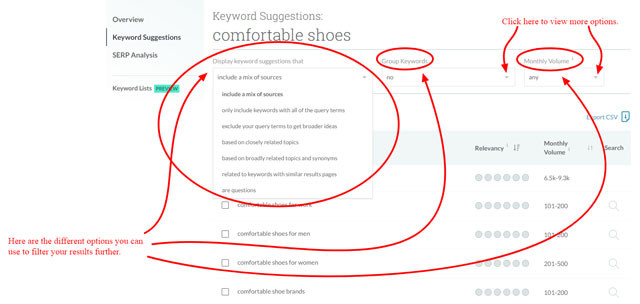
As you can see, it’s possible to group keywords, sort them according to their monthly search volume, or to display keywords suggestions that:
- Include a mix of sources
- Only include keywords with all of the query terms
- Exclude your query terms to get broader ideas
- Are based on closely related topics
- Are based on broadly related topics and synonyms
- Are related to keywords with similar results pages
- Are questions
These options provide you with plenty of possibilities and ideas. Let’s play a bit and see what happens if we choose to display keywords suggestions that are questions since we know that headlines in the form of a question are usually considered to be among the most catchy and compelling ones.

Exploring all these keywords suggestions mostly from the first page, you might come up with some headline ideas like these:
- Stride with confidence and style in these 11 comfy flat leather sandals,
- 24-hour comfort guaranteed with these 23 super soft walking shoes,
- Work all day with no pain in this stylish and ultra comfortable footwear,
- How to find warm and comfortable boots without compromising style, etc.
Not bad at all! On the contrary! Come on, give it a try! We bet you can think of more great ideas.
Don’t you think that every copywriter can easily gather new ideas with the help of a few of the tools we’ve presented?
Is that all you can do? Is there anything else that can help you overcome that awful feeling of not having a clue what to write about? Of course, there is!
Idea #7: Use Blog Topic/Headline Generators
With all this help, you mustn’t get that blogger’s block get you down! There are some more valuable tips and tools to kick-start your inspiration – blog topic or headline generators.
They are using the proven formulas and applying them to your keywords. That’s how you can get some ready-made headline/topic suggestions. Those headlines can then serve you for further inspiration. Amazing, isn’t it?
However, always make sure you add your own creativity element to the already existing generated titles they offer in order to arouse curiosity and make those title suggestions even more effective and enticing.
Here are just a few such tools you’ll find helpful. Let’s just briefly demonstrate how they work on our keywords example ‘comfortable shoes’.
1: HubSpot Blog Topic Generator
All you need to do here is to type in three nouns related to your topic and you’ll get title suggestions for your blog posts. Some of them turn out to be useless, others may be excellent, but the point is that most of them are good triggers for your own headline and blog topic ideas.
First, we typed in these nouns related to our topic: shoes, comfort, style.
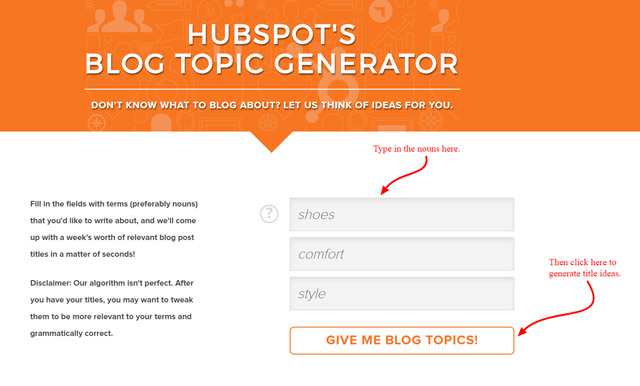
And here’s what we got.
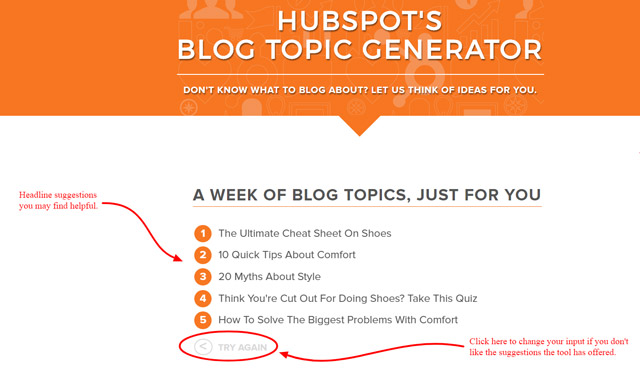
You can use the very first suggestion but you can also tweak the other ones to make them more appropriate and specific to your topic.
Suppose we don’t like these headlines. Is there anything else we can do? Yes! Just click Try Again, change the nouns you typed in and generate some new titles.
Let’s do it! This time we’ll enter the nouns footwear, walking, and leather and repeat the whole process with only one click.
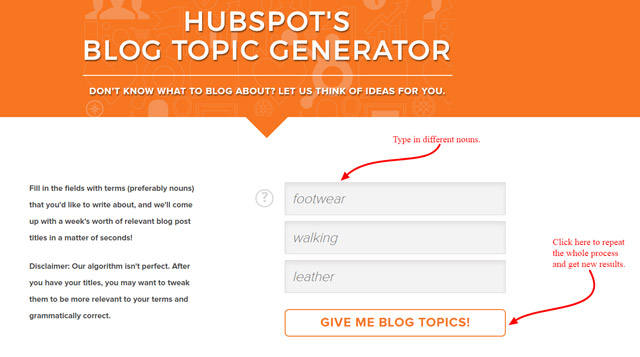
Here are the new results based on our fresh input.
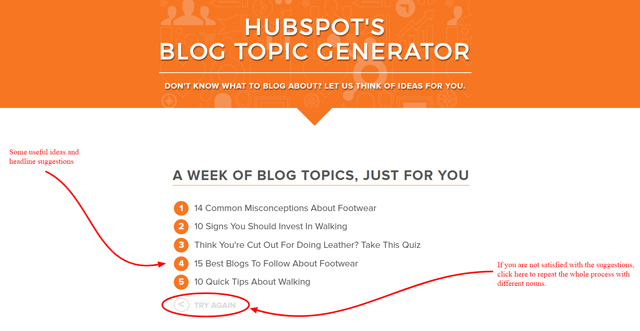
Don’t you agree that we could think of some decent headlines based on these? For example, 13 signs your expensive new shoes aren’t worth the money you paid for them or, let’s say, 7 quick tips on how to choose comfortable shoes.
What’s more, we could even use some of the ready-made headlines as they are, such as 14 common misconceptions about footwear or 15 best blogs to follow about footwear.
The beauty of this tool is that you can repeat the whole procedure over and over again until something really inspiring appears.
2: Portent Content Idea Generator
This tool requires entering only one keyword related to your subject matter to generate headline ideas based on it.
Look what we got when we typed in our keyword ‘shoe’. The suggested title is 20 movies with unbelievable scenes about shoes.
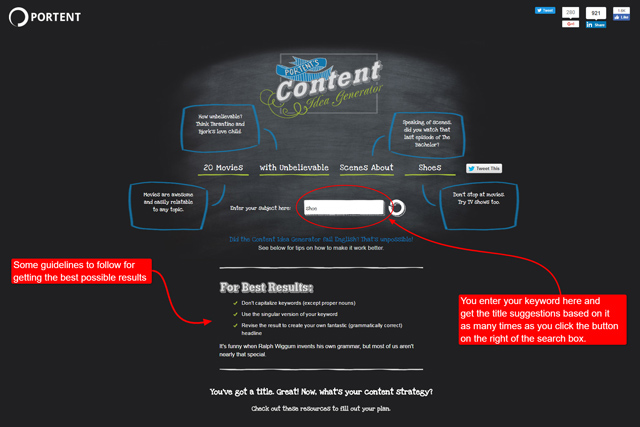
Sounds interesting? If not, you can also repeat the process and get some different ideas. We also got these suggestions:
- 5 things about shoes your teacher wouldn’t tell you,
- The simplest ways to make the best of shoes,
- Why shoes will change your life,
- Why shoes are the 51st shade of grey,
- 8 uses for shoes.
Admittedly, some of these sound odd but with just a little bit of adjustment, they can do wonders for your new blog posts. It’s worth thinking about that.
3: Inbound Now blog title idea generator
This tool claims to ‘kill writer’s block’ and provide you with a whole bunch of titles that will inspire hundreds of fresh blog post ideas. All you need to do is hit the button ‘Click to Generate Title Idea!’ and wait for the results. It looks like this:
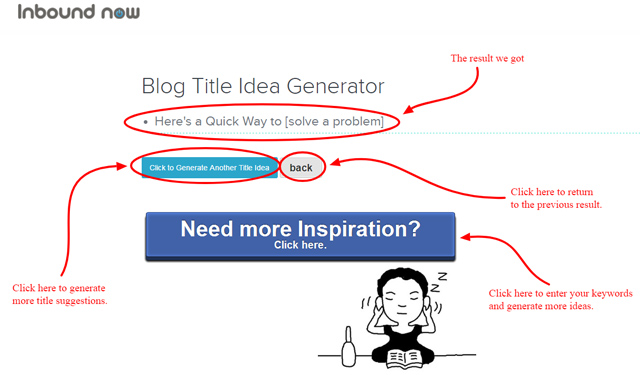
Here are some ideas we got after entering our keywords we might find useful when writing an article for our imaginary shoes online store:
- 5 advantages of wearing clogs as nursing shoes
- Are you insane if you wear creepers?
- Anatomically correct shoes: what you need to know
- The importance of wearing comfortable shoes
All these titles already exist online but they can be used for inspiration, of course, along with many other relevant templates suggested by this tool.
4: Build Your Own Blog Ideas Generator
Another similar tool which is ‘ready to serve when your brain is out of service’ can help you build your own blog and come up with content ideas. It looks like this:
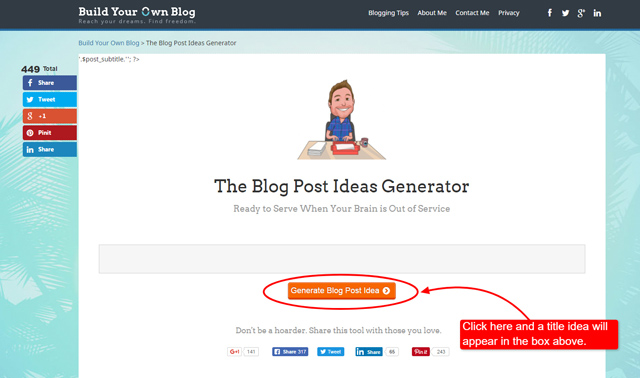
Just click on Generate Blog Post Ideas and choose from the suggestions that will appear in the field above the button. Unfortunately, you can’t type in your keywords here. The only thing you can do is to adjust the title suggestions and make them fit your topic area.
Go ahead, play with it.
5: Linkbait Generator
Here’s another helpful tool for generating Linkbait title ideas. Although it’s NOT highly advisable to create such titles, this tool can also help you find the necessary inspiration.
Here’s how it works.
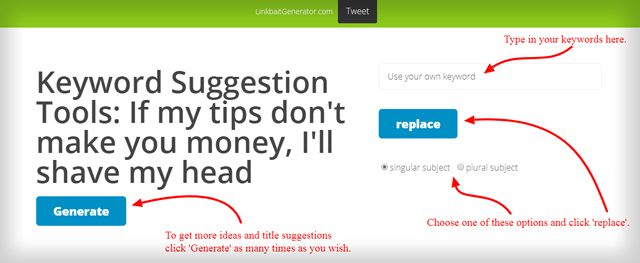
So, let’s check it out and see what it offers when we enter our so far well-known keywords ‘comfortable shoes’. If you take a closer look at the results below, you’ll notice that it’s possible to find some inspiring suggestions.
With some adjustments, you can create great headlines for your blog articles.
Feel free to take a glance and think of your own headlines and content ideas based on these suggestions.
6: Tweak Your Biz Title Generator
The last tool we’re going to present to you has more options than the previous ones. It groups the suggested titles into several categories and you can choose how you want them to appear.
Have a look at the screenshot below to see how it works. Just enter your keywords, mark the options you want, and click on Submit. We got these results for ‘comfortable shoes’.
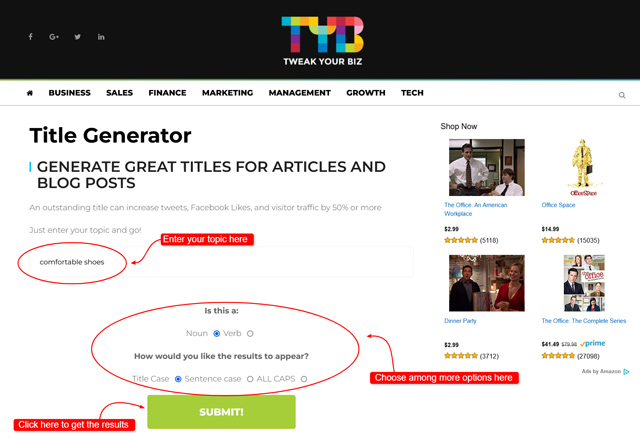
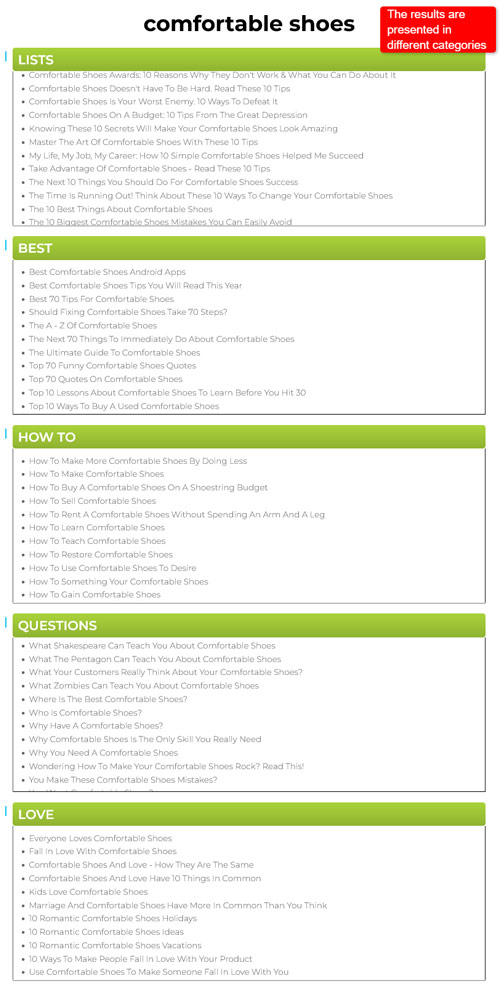
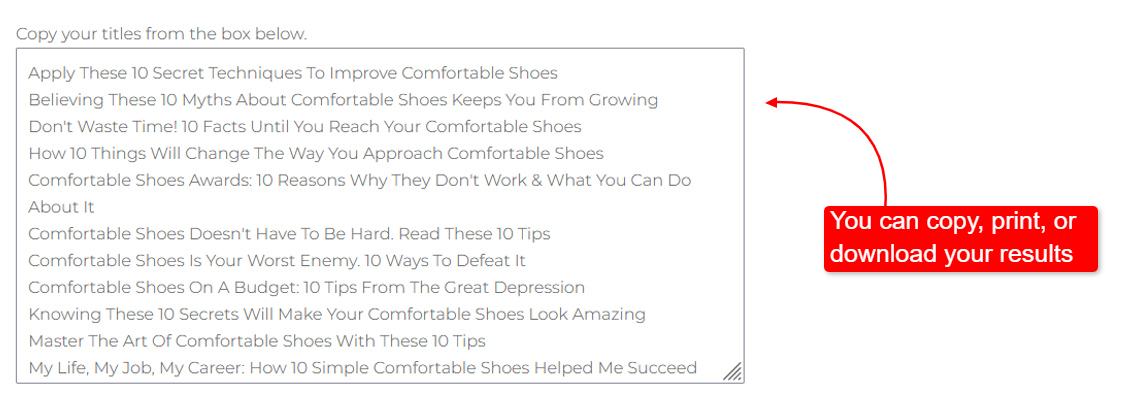
Now you’re equipped with all the necessary tools that can help you get fresh ideas for your blog articles. Let’s just briefly summarise the main points and guidelines of this lesson.
In Summary
Blogging is a must for any business today. It has become one of the most powerful tools that can help you bring in more prospects while providing value to all of your customers.
It is also a great way to improve your writing abilities which can be very useful to your business.
On the other hand, it can be mentally challenging to create new enticing and valuable content constantly in order to compete for consumers’ attention.
With a list of ideas on hand, it will be easier for you to choose the right topic for your customers to read. Put yourself in your reader’s shoes and ask yourself ‘why should I read this blog post?’.
The topic that you choose should be able to address this question because that’s one of the reasons why readers visit a blog in the first place. They may be looking for information about certain products in your store or answers to their questions, and your choice of topic should be able to address those.
Leverage the following options to help you develop fresh blog post ideas and articles as quickly and easily as possible.
- Use the existing eCommerce store assets in crafting a blog post, and these are your customers’ feedbacks and emails, your products and business in general.
- Brainstorm, plan and come up with ideas together with your eCommerce store owner and peers.
- Use various keywords on post title and body, as well as various keywords tools to generate more fresh ideas.
- Blog topic/headline generators can also help you come up with some fabulous ideas for your new articles.
Having been armed with all the valuable tips and tools from this lesson, the process of generating ideas for new blog posts should NOT be a burden for you anymore.
Moreover, they should help you never worry about blog topics again, not to mention running out of them! Good luck with your writing!
